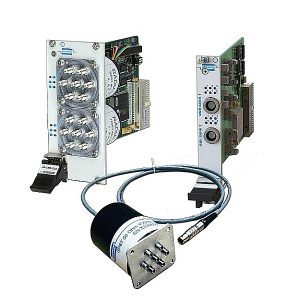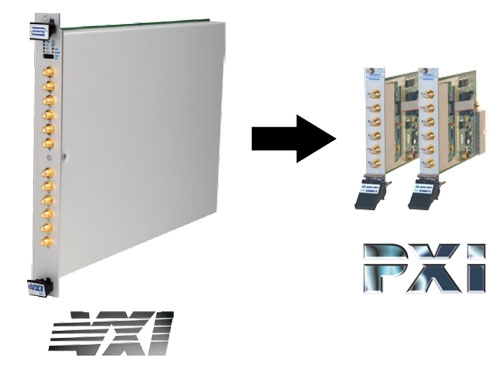- The modular instrumentation in VXI format, created in 1987, has long proven its performance in automatic test systems.
- With the advent of the PXI standard in 1997 and the many instruments that have adopted this format, it can only be seen that the new VXI cards introduced on the market are very rare.
- In addition to its lower cost, PXI instrumentation has many other advantages that should encourage designers of electronic test systems to consider, for those who have not yet done so, the transition from VXI to PXI.
- Pickering Interfaces, a specialist in PXI switching systems, explains the main reasons for this in this article.
In its day, VXI technology was a definite step forward. Built upon the modular VME computer bus, VME eXtensions for Instrumentation, or VXI, reduced the size and increased the performance of high-end test systems. Instead of bulky rack-and-stack systems, whose instruments were connected by the relatively slow GPIB interface, VXI systems featured modular instrumentation that plugged into a modified VMEbus that provided higher data transfer rates and real-time performance not possible with rack-and stack systems.
The VXIbus has served test and measurement engineers well, but it is more than 30 years old now, and it may be time to move to a more modern platform. Today, more test systems designers are choosing the PCI eXtensions for Instrumentation (PXI) platform when designing new modular test systems or replacing or updating existing test systems. Originally introduced in 1997 by National Instruments, PXI is now supported by nearly 70 companies working under the umbrella of the PXI Systems Alliance (PXISA), which publishes the PXI specification and ensures instrumentation interoperability.
PXI’s big advantage: lower cost
PXI’s biggest advantage over VXI is product availability. In the nearly 30 years since VXI was introduced, the Consortium that manages the specification has gone from over 40 companies down to just eleven members. Even Pickering has dropped their VXI line due to key part obsolescence and reduced market requirements. A large number of the products that were available in VXI in the past are now obsolete and are often only available on the used market. That is not to say that VXI is no longer viable. In some specialized applications like Data Acquisition, there are VXI vendors producing new products. In other applications, VXI is mostly recommended for legacy applications and not for new designs.
A second reason to look closer at PXI is that hardware costs are lower than VXI. Because PXI is based on the PCI bus, which is used in many personal computers, it can take advantage of the advances being made to serve the PC marketplace. Because many of the components used in PXI modules are also used for PCI modules, they cost less because so many more of them are made. This leads to overall reduced cost for PXI modules when compared to VXI modules. PXI systems typically cost one-half to one-third the cost of an equivalent VXI system.

40-785B Series PXI Multiplexer from Pickering Interfaces
Some of the other advantages that PXI enjoys over VXI include:
- Data transfer. Standard PXI can transfer data that is 8, 16, 32, or 64 bits wide. VXI can only transfer data that’s 8, 16, or 32 bits wide.
- Data throughput. Because PXIe (Express version of PXI) systems can transfer data over high speed serial busses, the maximum throughput for PXI systems is higher than that for VXI systems. The maximum throughput for VXI systems is only 160 Mbytes/s, while the maximum throughput for PXIe systems is 12 Gbytes/s.
- Size. PXI modules are smaller than equivalent VXI modules. In fact, PXI systems have the smallest footprint of any open-architecture instrumentation system. This is a big advantage for PXI test systems because as test systems become more complex, test system developers need to cram more functionality into their test systems. PXI lets them do this while at the same time keeping test system size manageable.
- Instrument availability. Aside from perhaps some very specialized instrumentation (an example would be Bustec with their specialized data acquisition systems), whatever you can buy in VXI, you can also buy in PXI. And, the trend is clear. There are fewer new VXI modules being developed than new PXI modules, and that will continue into the future as more designers specify PXI over VXI. In some applications, such as fault insertion during simulation, there are no VXI modules available. Also, because PXI is based on the CompactPCI specification, you can use CompactPCI boards in a PXI system.
Making the right choice
While the availability of PXI switching and instrumentation modules makes the choices relatively easy, there is the issue of migrating test programs from VXI to PXI, specifically in switching applications. The ability to replicate original test configurations to support legacy FRUs (Field Replaceable Units) is important to continue supporting older test programs while planning for future requirements.
To help ease this transition, Pickering has developed PXI switching and simulation modules that closely match the operation of VXI switching modules from Racal, VTI Instruments, Agilent (Keysight), and other manufacturers. And, Pickering’s policy of supporting their PXI Switching products for 15 to 20 years, or even longer, means that your next-generation test systems will have as long a life as their predecessors. An example of the Pickering VXI to Pickering PXI is seen below.
The Pickering PXI modules listed in the table above are in many cases a close equivalent to the VXI modules. Because of the large PCB real estate of C-Size VXI modules, channel counts may be different, and specifications may not be exactly the same. Depending on your application, a different Pickering PXI module may be closer to your requirements than what is shown here. Please contact Pickering’s support team for more assistance in finding the correct module for your requirements.

Pickering’s software front panels
Migration issues
While PXI is clearly the modular platform of choice when designing new test systems or upgrading existing systems, you may encounter some issues when doing so. One of them is module real estate. Clearly, a C-size VXI module has a lot more area to mount components, meaning that some VXI modules may have more features or functionality than a PXI module that you might choose to replace it. On the whole, however, VXI module designs are not as dense as today’s PXI module, so this is usually not an issue.
A related issue that you will have to address when migrating to PXI is cabling. VXI modules have a wider front panel (1.188-in.) than PXI modules (0.8-in.), meaning that many of the connectors used in VXI systems cannot be used in a PXI system. So, plan on building or buying new cables or buying adaptors.
If your instruments dissipate a lot of power, you may have cooling issues when migrating to a PXI system. The PXI cooling spec is less stringent than the VXI specifications, and generally, PXI chassis do not have the cooling power of VXI chassis. You may use multiple slots to achieve the necessary cooling.
Software is another area of concern. There is no easy way to migrate test programs. But, given the number of good test-development software packages available for the PC platform, this may not be as big an obstacle as it might appear.
Despite these drawbacks, if you’re an automatic test system developer, the question is clear. It’s not if, but when you should move to PXI-based systems from VXI. The answer is pretty clear, too. The answer is now.







